Archive Record
Images
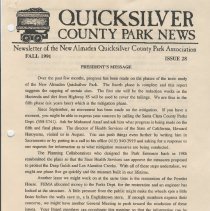


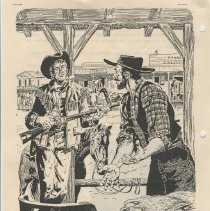
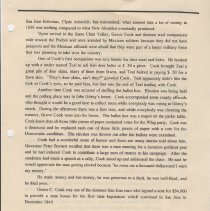
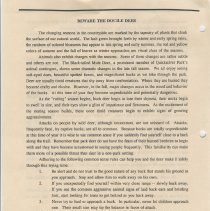
Additional Images [10]
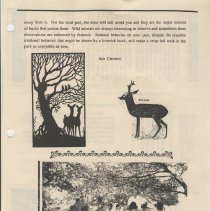
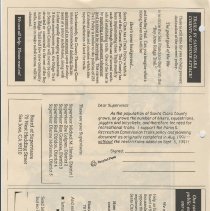
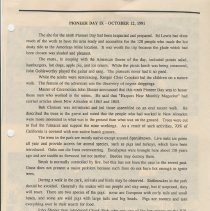
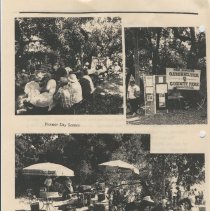
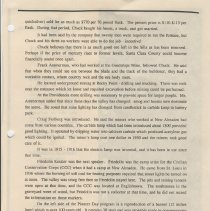

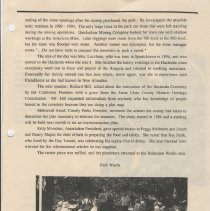

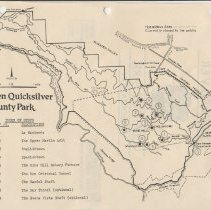
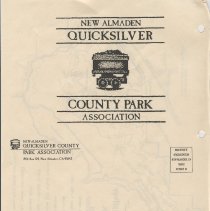
Metadata
Catalog number |
1997.2.2600 |
Object Name |
Newsletter |
Date |
1991 |
Description |
TITLE: Quicksilver County Park News SUBTITLE: Newsletter of the New Almaden Quicksilver County Park Association Issue # 28 Fall 1991 Newsletter of the New Almaden Quicksilver County Park Association FALL 1991 ISSUE 28 PRESIDENT'S MESSAGE Over the past few months, progress has been made on the phases of the toxic study of the New Almaden Quicksilver Park. The fourth phase is complete and this report suggests the capping of certain sites. The first site will be the reduction works in the Hacienda and dirt from Highway 85 will be used to cover the tailings. We are thus in the fifth phase (six years later) which is the mitigation phase. Since September, no movement has been made on the mitigation. If you have a moment, you might be able to express your concern by calling the Santa Clam County Parks Dept. (358-3741). Ask for Mohamed Assaf and ask him what progress is being made on the fifth and final phase. The director of Health Services of the State of California, Howard Hatoyama, visited us in August. You can push things even further by writing him in Sacramento or by putting in a call to his office (415) 540-3919 and asking for a response to our requests for information as to what mitigation measures are being conducted. The Planning Collaboratives who designed the Park Entrance back in 1986 resubmitted the plans so that the State Health Services can approve the measures proposed to protect the Deep Gulch and Los Alamitos Creeks. With all of these steps undertaken, we might see phase five go quickly and the museum built in our lifetime. Another issue we might work on at the same time is the restoration of the Powder House. FEMA allocated money to the Parks Dept. for the restoration and an engineer has looked at the structure. A little pressure from the public might make the wheels spin a little faster before the ways cave in, a la Englishtown store. If enough members express their concerns, we might have another General Meeting to push toward the resolution of these issues. Your Board members can coordinate this meeting so that the information can be presented to a large group. We could push for a public hearing in early December. We had such a wonderful 9th Annual Pioneer Day this year that if we stress action on the Reduction Works site, perhaps our 10th Annual Pioneer Day could be held at that site along with the distribution of Jimmie Schneider's book, Quicksilver. Kitty Monahan FROM THE RECORD BOOK OF JOHN ATWOOD As you may recall, John, an employee of the New Idria Mining and Chemical Company, worked at the New Almaden Quicksilver Mine from November 1968 until September 1969. The excerpt below is about breaking through to the Almaden and what was found and encountered. "May 1, 1969. At about 24' from the center line of the April Tunnel we broke into the Almaden 500 level (400D) drift. All the old workings that are in silica carbonate are wide open. The sink to the 600 level is open and ladders are being put in so (hat it may be explored. Found quite a few colors in the 400D drift and the D4 raise. Also found a few souvenirs, several square nails, a hitch cutter, powder box, and two empty snuff cans." "May 2, '69. Carried survey into Almaden 500 level." "May 8, '69. It was found that the 600 level was full of water and part of the raise to the 500 level so a pump was lowered. Today the water level was low enough for inspecting on the 600 level. The underground foreman says it is not safe because of bad ground and several feet of water. No further work will be done to open the 600 level Almaden Shaft." DATES TO REMEMBER Tuesday, December 10 Pot Luck Christmas Party at New Almaden Community Center on Bertram Road; 6:00 p.m. For further information call Kitty at 268-6541 Tuesday, December 10 Santa Clara County Supervisors Board Meeting, voting on trail easement policy. During the day. PUBLICATION STAFF Virginia Hammerness - Editor Sue and Ron Wolfe - Word Processing Kitty Monahan and Virginia Hammerness - Camera Ready Dick Frost - Labels Dick Wachs - Mailing GRAVE OF FIRST AMERICAN TO OWN MINE MARKED A ten pound piece of cinnabar ore now rests on the grave of Grove C. Cook who owned part of the world-famous New Almaden Mine two years before quicksilver was discovered on the land. Cook, in 1845, bought 4,400 acres of Rancho de los Capitancillos for $330 in silver and $25 in goods. Cook had come overland with the Bidwell-Bartleson party in 1841, the first emigrant party to cross the Sierras into California. He lived in Santa Clara County and was involved in business in San Jose, served on the San Jose Pueblo government, and had a minor part in the Battle of Santa Clara, a portion of the war for independence from Mexico. While on a visit to Santa Cruz in February 1852, Cook died and was buried in the little sidehill Evergreen Cemetery. Last September 28, his grave, which has never had a headstone, was marked by the California-Nevada-Hawaii Chapter of the Oregon California Trails Association in cooperation with the New Almaden Quicksilver County Park Association and the Santa Cruz Historical Trust, which has charge of the cemetery. After quicksilver was discovered, Cook and associates formed the Santa Clam Mining Company. However, in December 1848, they sold out to eastern interests for $63,000. An Illustration titled Grove Cook Plaque and Cinnabar Marker at Evergreen Cemetery Santa Cruz San Jose historian, Clyde Arbuckle, has maintained, what seemed like a lot of money in 1848 was nothing compared to what New Almaden eventually produced. Upon arrival in the Santa Clara Valley, Grove Cook and thirteen trail companions rode toward the Pueblo and were arrested by Mexican soldiers because they did not have passports and the Mexican officials were afraid that they were part of a larger military force that was planning to take over the country. One of Cook's first occupations was as a hunter for deer meat and hides. He hooked up with a trader named Teal to sell him deer hides at $ .50 a piece. Cook brought Teal a great pile of deer skins, many of them from fawns, and Teal balked at paying $ .50 for a fawn skin. "They's deer skins, ain't they?" growled Cook. Teal apparently didn't like the look in Cook's eyes, so he paid him, but that was the end of Teal trading with Cook. Another time Cook was accused of stuffing the ballot box. Election was being held and the polling place was in John Gilroy's home. Cook accompanied some county officials who thought it would be a good time to collect taxes while everybody was voting at Gilroy's ranch. During the afternoon there was a foot race, and while everybody was cheering the runners, Grove Cook went into the house. The ballot box was a teapot on the parlor table. Cook knew that all those little pieces of paper contained votes for the Whig party. Cook was a democrat and he replaced each one of those little pieces of paper with a vote for the Democratic candidate. The election was thrown out after the ballots were examined. Cook had a wonderful sense of humor and there are many stories told about him. Governor Peter Barnett recalled that there was a man running for a lucrative political post and he had induced Cook to contribute a large sum of money to his campaign. After the candidate had made a speech at a rally, Cook stood up and addressed the chair. He said he would appreciate the man getting elected because "he owes me a thousand dollars and I want my money." He made money and lost money, he was generous to a fault, he was well-liked, and he died poor. Grove C. Cook was one of the nineteen San Jose men who signed a note for $34,000 to provide a state house for the first state legislature which convened in San Jose in December 1849. BEWARE THE DOCILE DEER The changing seasons in the countryside are marked by the tapestry of plants that cloak the surface of our natural world. The lush green brought forth by winter and early spring rains, the rainbow of colored blossoms that appear in late spring and early summer, the red and yellow colors of autumn and the fall of leaves as winter approaches are visual clues of the seasons. Animals also exhibit changes with the seasons. Some of these changes are rather subtle and others are not. The Black-tailed Mule Deer, a prominent member of Quicksilver Park's animal contingent, shows some dramatic changes in the late fall season. We all enjoy seeing soft-eyed does, beautiful spotted fawns, and magnificent bucks as we hike through the park. Deer are usually timid creatures that shy away from confrontation. Where they are hunted they become crafty and elusive. However, in the fall, major changes occur in the mood and behavior of the bucks. At this time of year they become unpredictable and potentially dangerous. As the "rutting" season begins, buck deer begin to lose their shyness, their necks begin to swell in size, and their eyes show a glint of impatience and fierceness. As the excitement of the mating season builds, these once timid creatures begin to exhibit signs of growing aggressiveness. Attacks on people by wild deer, although uncommon, are not unheard of. Attacks, frequently fatal, by captive bucks, are all to common. Because bucks are totally unpredictable at this time of year it is wise to use common sense if you suddenly find yourself close to a buck along the trail. Remember that park deer do not have the fears of their hunted brethren to begin with and they have become accustomed to seeing people frequently. This familiarity can make them more of a possible threat than deer in a non-park setting. Adhering to the following common sense rules can help you and the deer make it safely through this trying time: 1. Be alert and do not trust to the good nature of any buck that stands his ground as you approach. Stop and allow him to walk away on his own. 2. If you unexpectedly find yourself within very close range -- slowly back away. If you see the common aggressive animal signs of laid back ears and bristling hair, start looking for trees to get behind as you back away. 3. Never try to feed or approach a buck. In particular, never let children approach one. Their small size may tip the balance in favor of attack- 4. Look for the presence of does with a buck and never get between a buck and doe. 5. Expect the unexpected. Your dog may normally be a deterrent to any deer approaching you, but at this time of year, he may provide the provocation for a nasty encounter. These precautions are meant to insure your enjoyment of the park and not to scare you away from it. For the most part, the does will still avoid you and they are the major interest of bucks that pursue them. Wild animals are always interesting to observe and sometimes these observations are enhanced by distance. Rational behavior on your part, despite the possible irrational behavior that might be shown by a lovesick buck, will make a crisp fall walk in the park as enjoyable as ever. Bob Clement TRAILS IN SANTA CLARA =COUNTYARE UNDERATTACK! There is still time for you to help prevent decimation of the current policy. The great goal of the 90s is to circle the San Francisco Bay with the "Bay Area Ridge Trail." and the Bay Trail. Can you imagine what a hiking heaven this will be! Here's some background...Santa Clara has a Trails Policy which is part of the General Plan. The County has been implementing these Trails steadily each year through the use of several meth-ods of establishing trails. One of the best is by requiring a trail easement whenever land is about to be developed. This current Trail Policy is similar to the policies of 232 California cities and counties which also require dedication of land for trails. Unfortunately, the County Planning Com-mission recommended deleting the requirement of an easement upon development of a minor subdivision, along with 2 other equally damaging amendments. If these amendments pass, the Ridge Trail in Santa Clara County will never be constructed or connected to the rest of the Bay Area Ridge Trail and few new community trails, even in major subdivisions, will be obtained. These are your Supervisors: Supervisor Michael M. Honda, District 1 Supervisor Zoe Lofgren; District 2 Supervisor Ron Gonzales, District 3 Supervisor Rod Diridon, District 4 Supervisor Dianne McKenna, District 5 Board of Supervisors 70 West Hedding Street San Jose, CA 95110 Our campaign is to generate a public outcry against weakening our current trails policy. We are asking you to join us! Help us Save Our Trails by letting the Board of Supervisors know that there are thousands of trail users like you who oppose this blatant attempt to prevent implementation of any future trails in Santa Clara County. How can you help? Voice your concerns. Attend the meeting. December 10,1991 1:30 PM Board of Supervisors chambers 70 West Hedding, San Jose. And send letters postcards or even telephone. Send letters and postcards NOW, but no later than December 1st. PIONEER DAY IX - OCTOBER 12, 1991 The site for the ninth Pioneer Day had been inspected and prepared. Ed Lewis had done much of the work to have the area ready and accessible for the 120 people who made the hot dusty ride to the American Mine location. It was worth the trip because the glade which had been chosen was shaded and pleasant. The menu, in keeping with the American theme of the day, included potato salad, hamburgers, hot dogs, apple pie, and ice cream. While the picnic lunch was being consumed, John Goldsworthy played the guitar and sang. The pioneers never had it so good. While the adults were reminiscing, Ranger Chris Crockett led the children on a nature walk. The feature of the adventure was the discovery of coyote droppings. Master of Ceremonies John Slenter announced that this ninth Pioneer Day was to honor those men who worked in the mines. He said that "Harpers New Monthly Magazine" had carried articles about New Almaden in 1863 and 1865. Bob Clement was introduced and led those assembled on an oral nature walk. He described the trees in the grove and noted that the people who had worked in New Almaden were more interested in what was in the ground than what was on the ground. Trees were cut to fuel the furnaces and support the mine workings. As a result of such activities, 70% of California is covered with non-native bunch grasses. The trees in the park are mostly native except around Spanishtown. Live oaks are green all year and provide acorns for animal species, such as pigs and turkeys, which have been introduced. Oaks can die from overwatering. Eucalyptus were brought here about 150 years ago and are usable as firewood but not lumber. Beetles may destroy them. Brush is normally controlled by fire, but this has not been the case in the recent past. Grass does not present a major problem because such fires do not bum hot enough to ignite trees. During a walk in the park, animals and birds may be observed. Rattlesnakes in the park should be avoided. Generally the snakes will see people and stay away, but if surprised, they will react. There are two species of the pigs: some are European with curly tails and small heads, and some are wild pigs with large tails and big heads. Pigs are rooters and turn everything over in their search for food. John Slenter then introduced Chuck Rich who was one of the last miners on the Hill. When New Idria Mining Company, which owned the property, decided that it could no longer work the mine profitably because, among other factors, safety and health regulations for companies with ten or more employees required large expenditures of money, Chuck and three men decided to work the mine as self-employed individuals. He said that his group worked the mine between 1964 and 1966. These were profitable years because mercury (also known as quicksilver) sold for as much as $770 per 76 pound flask. The present price is $110-$115 per flask. During that period, Chuck bought his house, a truck, and got married. It had been said by the company that twenty men were required to run the furnace, but Chuck and his three co-workers were able to do the job - incentive! Chuck believes that there is as much good ore left in the hills as has been removed. Perhaps if the price of mercury rises to former levels, Santa Clara County could become financially sound once again. Frank Ammerman, who had worked at the Guadalupe Mine, followed Chuck. He said that when they could see ore between the blade and the track of the bulldozer, they had a workable contact, where country rock and the ore body meet. He learned underground mining at Rocky Point - drilling and mucking. There was rock near the entrance which let loose and required excavation before mining could be performed. At the Providencia more drilling was necessary to provide space for larger people. Mr. Ammerman added that since those days the valley has changed: smog and houses now dominate the scene. He noted that mine lighting has changed from candlestick to carbide lamp to battery pack. Craig Stolburg was introduced. He said the miners who worked at New Almaden had come from various countries. The carbide lamp which had been introduced about 1800 provided good lighting. It operated by dripping water into calcium carbide which produced acetylene gas which could be ignited. The miner's lamp cost one dollar in 1950 and the miners took good care of it. It was in 1915 - 1916 that the electric lamp was invented, and it has been in use since that time. Friedolin Kessler was the next speaker. Friedolin was the camp artist for the Civilian Conservation Corps (CCC) when it had a camp at New Almaden. He came from St. Louis in 1936 where the burning of soft coal for heating purposes required that street lights be turned on at noon. The valley was smog free then so Friedolin stayed here. The pits and mining tunnels were open at that time, and the CCC was located at Englishtown. The tombstones in the graveyard were of wood, but Friedolin was not a collector at that time, and he did not record the information on those markers. On the left side of the Pioneer Day program is a reproduction of a banner (12 inches long) which is over 100 years old. It contains 38 stars and was probably made to commemorate Colorado's statehood. The banner was embroidered possibly around 1876 with machine or hand done precision. Steven Saunder, retired superintendent of the Hacienda School, was introduced by Friedolin. Mike Cox, a geologist who was here during the twilight days of mining, described the sealing of the mine openings after the county purchased the park. He investigated the possible toxic residues in 1989 - 1990. The only large trees in the park are those that were left standing during the mining operations. Quicksilver Mining Company looked for more ore with shallow workings at the American Mine. Later diggings were made from the 700 level to the 900 level, but the mine was flooded with water. Another tunnel was attempted, but the mine manager wrote "...Do not have tools to conquer the mountain in such a mood." The star of the day was Mrs. Lucchese, who was born in Spanishtown in 1894, and who moved to the Hacienda when she was 8. She recalled the balmy evenings in the Hacienda when everybody went out in front and played in the Acequia and listened to strolling musicians. Eventually her family moved into San Jose where, never again, was she to experience such friendliness as she had known in New Almaden. The next speaker, Richard Hill, talked about the restoration of the Hacienda Cemetery by the California Pioneers with a grant from the Santa Clara County Historic Heritage Commission. Mr. Hill requested information from anybody who has knowledge of people buried in the cemetery because they are doing a plot map. Mohamed Assaf, County Parks Director, reviewed the actions the county had taken to determine the plan necessary to relocate the museum. The study started in 1984 and a meeting will be held next month to set an implementation plan. Kitty Monahan, Association President, gave special thanks to Peggy Melbome and Dutch and Nancy Mapes for their efforts in preparing the food and tables. She noted that Ray Stark, who lived by the Day Tunnel, was celebrating his eighty first birthday. She also thanked John Atwood for the informational articles he has supplied.The center piece was raffled, and the picnickers returned to the Reduction Works area. Dick Wachs PIONEER DAY October 12, 1991 The America Shaft The mine was opened in September, 1863. The workings were plagued with hard rock and excessive water. In 1885, a steam hoisting works and pump were installed and functioned until 1888, when the underground area was subjected to great flooding, submerging the equipment and rousing the abandonment of the mine. The shaft reached a depth of 700 feet. Master of Ceremonies John Slenter America Mine Miners Frank Kambish Chuck Rich Ray Stark and many others Entertainment John Goldsworthy Banner Information The banner, on the left, was discovered at a flea market in New Almaden several years ago. The 38th star was added July 4, 1877 and represented the state of Colorado, admitted as a state in August, 1876. |
People |
Ammerman, Frank Arbuckle, Clyde Assaf, Mohamed Atwood, John Clement, Bob Cook, Grove C. Cox, Michael Crockett, Chris (Christopher) Frost, Dick Gilroy, John Goldsworthy, John Hammerness, Virginia Giannini Hill, Richard Kessler, Friedolin Lewis, Ed Lucchese, Mrs. Monahan, Kitty Rich, Chuck Saunders, Stephen Wells Slenter, John Stolburg, Craig Wachs, Richard Wolfe, Ron Wolfe, Sue |
Cataloged by |
Meyer, Bob |
